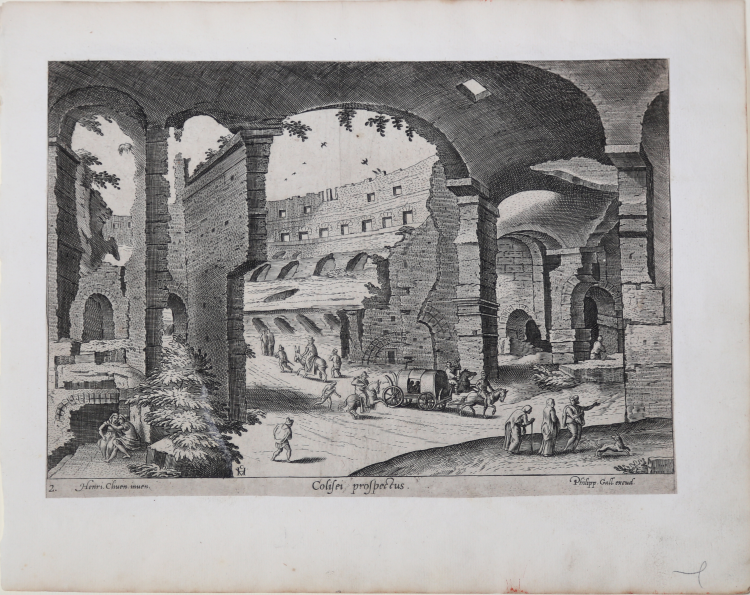



| Reference: | S36245 |
| Author | Hendrick van CLEEVE |
| Year: | 1587 |
| Zone: | Colosseum |
| Printed: | Antwerpen |
| Measures: | 240 x 170 mm |


| Reference: | S36245 |
| Author | Hendrick van CLEEVE |
| Year: | 1587 |
| Zone: | Colosseum |
| Printed: | Antwerpen |
| Measures: | 240 x 170 mm |
Hendrick van Cleve or Cliven III, son and pupil of William van Cleve, moved to Italy in the second half of the XVI century; besides a painting depicting a view of Rome (1550), he realized a considerable amount of drawing which he afterwards used as preparatory for the engravings he realized in Antwerp and published by Philip Galle in 1587.
The views, whose main subject is Rome but there are also other European cities, bear the inscription “Henri. Cliven. inven." or "Henri Cliven pingebat" on lower part, which testify their origin, but not necessarily the fact that he realized them.
Engraving, good impression on contemporary laid pape, very good conditions.
|
Hollstein, 6
|
Hendrick van CLEEVE (Anversa 1524 - 1589)
|
Son of Willem and brother of the painter Marten, Hendrick Van Cleeve, painter and engraver, was trained in Flemish master Frans Floris’s establishemnt. Following the example of other Flemish artists, Van Cleev made a trip to Italy, particularly to Rome, where he completed his education. He had the chance to draw from life views, landscapes and ruins that he later on used as preparatory drawings for his paintings, as recorded in 1621. Van Mander states that Van Cleev, apart from his early notes, used Melchior Lorch’s sketches to realize his views. His set of works is still debated and unclear for he signed only the 38-sheets series "RUINARUM VARI PROSPECTUS RURIUMQ. ALIQUOT DELINEATIONES", and the 12 plates of " Regionum rurium, fundorumque, varii amoeni prospectus", both issued by the Antwerp publisher Philip Galle (Haarlem 1537 - Antwerp 1618).
|
|
Hollstein, 6
|
Hendrick van CLEEVE (Anversa 1524 - 1589)
|
Son of Willem and brother of the painter Marten, Hendrick Van Cleeve, painter and engraver, was trained in Flemish master Frans Floris’s establishemnt. Following the example of other Flemish artists, Van Cleev made a trip to Italy, particularly to Rome, where he completed his education. He had the chance to draw from life views, landscapes and ruins that he later on used as preparatory drawings for his paintings, as recorded in 1621. Van Mander states that Van Cleev, apart from his early notes, used Melchior Lorch’s sketches to realize his views. His set of works is still debated and unclear for he signed only the 38-sheets series "RUINARUM VARI PROSPECTUS RURIUMQ. ALIQUOT DELINEATIONES", and the 12 plates of " Regionum rurium, fundorumque, varii amoeni prospectus", both issued by the Antwerp publisher Philip Galle (Haarlem 1537 - Antwerp 1618).
|